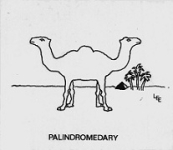 |
Lee Sallows |
|
| Home > Self-referential stuff > Reflexicons | ||
|
My article introducing reflexicons was written and published in Word Ways in 1992, since which time I did no further work on the topic. However, in 2018, twenty-six years later, I returned to the subject, whereupon I was embarrassed to discover a fault in the old program that could only mean certain results reported in the article were quite false*. Following a further delay of two years, here at last a corrected and much extended version of Reflexicons for public perusal.
*Specifically, my claim that the number of English language loops was four: one of period 155, one of period 14 and two of period 1 was incorrect. In this extensive re-write of Reflexicons I describe 24 distinct English loops, 9 of them of period 1, the remainder having periods of 2, 4, 5, 7, 11, 16, 26, 45 and 316. Sentences that inventory their own typography have a curiously dual character. On the one hand they are by definition terse and precise, the meaning they convey distilled into words that defy further condensation. To this extent they belong to poetry. On the other hand, their utterances are anything but essential, the very order of their words (in the list of letter totals they recite) being entirely arbitrary. The selfsame message can always be conveyed in a thousand alternative renderings. This is the antithesis of poetry. Self-intersecting reflexicons (which are largely the subject of my essay 'Reflexicons') represent an attempt to escape this arbitrariness through creating self-descriptors in which the position of words becomes significant. The result then becomes a structure in which "best words appear in best order", which was Sam Coleridge's definition of poetry. |
||
| Last Updated: 14-6-2020 |
||
| Copyright © Lee Sallows | ||